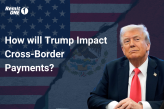Trump’s Threats to Cross-Border Payments: What It Means for Your Business March 18, 2025

It’s been a short while since Trump stormed back into office, and he’s already shaken things up with his hard-hitting policies—and, as always, he’s not one to shy away from bold and upfront decisions. But with every action comes a ripple effect, and in the world of cross-border payments, those ripples are turning into shockwaves. From proposed remittance taxes to intensified compliance risks, Trump’s latest moves are shaking up how money flows in and out of America.
So, what does this mean for businesses, migrants, and economies relying on these payments? Let’s find out.
- Will Deportations of Migrants Impact Remittances? Here’s What the Data Says
Mexicans, a huge diaspora, and one of the major remittances senders in the US, but we may see stricter immigration policies putting this financial lifeline at risk. The “Remain in Mexico” program has already led to nearly 11,000 migrants being sent back, potentially reducing the number of workers in the U.S. and, with them, the flow of cross-border payments. Since Trump’s arrival, 23,000 arrests have been made and 18,000 deportations, whilst it has risen significantly compared to the Biden administration it still remains lower than the peak levels seen during the early crackdown of Trump’s first term.
So, what does this tell us? When Trump first took office, deportations surged as part of his hardline immigration stance. But over time, the wave slowed down. Now, despite his promise to deport 11 million people, the sheer complexity of the process appears to make that goal unlikely. In fact, this could even open a window for some undocumented migrants to secure legal status. But let’s say, hypothetically, mass deportations would happen—would remittances take a massive hit? Not necessarily. Many undocumented migrants are low-value remitters, meaning their contributions wouldn’t cause a drastic drop. What would shake remittance flows, though, is something much bigger: a tax on remittances.
- Will a Remittance Tax on US-Latin America Transfers Disrupt the Market?
The proposed 10% remittance tax from the US to Latin American regions is an effort to minimise illegal immigration but can cause a significant dent on transactions, impacting money transfer operators, banks, and other players in the payments ecosystem by reducing revenue and lowering demand in certain corridors.
For countries like Mexico, El Salvador, and Haiti—where remittances inject nearly $150 billion annually, this could be a devastating blow. Families who depend on these funds risk losing critical income, putting entire economies under strain.
If implemented, Money Service Businesses (MSBs) may have no choice but to raise fees, potentially driving customers toward alternative solutions like digital wallets and crypto. Interestingly, Trump seems to support crypto, so could this be the turning point that finally makes it more secure and mainstream?
- Trump and Stablecoins: A Game-Changer for Cross-Border Payments?
There’s hope on the horizon—Trump’s pro-stablecoin stance could be the catalyst to reshape cross-border payments. While Trump has halted any action to progress America’s CBDC, he’s taken more steps to advance the crypto movement. In a tweet, he unveiled the U.S. Crypto Strategic Reserve, which will include XRP, SOL, and ADA, with Bitcoin (BTC), Ethereum (ETH), and other key cryptocurrencies that will be added to “the heart of the Reserve.” Since the announcement, the value of the first three coins surged by 62%, while BTC and ETH have climbed up by 10%. This momentum is pushing forward Trump’s goal of making the U.S. the “crypto capital of the world.”

Two posts by Donald Trump on Sunday, March 3, 2025, on his Truth Social account.
So, what does this mean for remittances? Stablecoins offer faster, cheaper, and more accessibility, eliminating high fees and long processing times, making this a more attractive alternative to existing transfer methods to senders.
Of course, regulation follows. Trump’s administration has called for a federal regulatory framework for digital assets to bring clarity. If well executed, this could boost financial inclusion and drive crypto adoption, but if it becomes too strict, it can do the opposite, where it stifles innovation and progression.
- Crypto in Crisis: What’s shaking the market?
The cryptocurrency market took a plunge over the weekend, and while crypto is no stranger to volatility, this time the drop wasn’t just about digital assets—it was about politics, economics, and the shifting global financial landscape.
A major trigger was the Trump administration’s new tariff hikes on imports from Mexico and Canada, which sent investors retreating from risky assets like Bitcoin, creating a domino effect across the sector. Then there was the regulatory uncertainty. The U.S. government’s new restrictions on crypto exchanges and stablecoins fuelled distrust, prompting even more selloffs. On top of that, fresh inflation data and Trump’s aggressive trade policies led to a reassessment of potential Federal Reserve interest rate cuts, putting even more pressure on risky assets like crypto.
Ironically, part of the turmoil can be traced back to Trump’s own cryptocurrency summit on March 7. The announcement of a strategic bitcoin reserve—a government-controlled stash of digital assets initially caused Bitcoin’s price to drop by 6%. While the move signalled greater government involvement in crypto, it left many investors questioning what that would actually mean in practice. The market’s uncertainty around this policy likely contributed to the larger crash that followed.
- Stricter Compliance: A Roadblock for Remittances?
The designation of cartels as terrorist organisations, combined with tighter immigration policies, is set to intensify compliance pressures on MSBs. They must now exercise even greater due diligence to avoid any unintended links to sanctioned groups.
For migrants, this means longer wait times, extra fees, and fewer options to send money home. If traditional corridors start shutting down, people will have no choice but to look elsewhere, whether that’s the age-old hawala system or the rising use of crypto and stablecoins, a shift that could play right into Trump’s pro-digital currency agenda.
Whereas for giants like Western Union and MoneyGram, who move billions to Latin America, the stakes are high. Stricter AML (Anti-Money Laundering) and KYC (Know Your Customer) regulations will be unavoidable, but for some financial institutions, the risk might be too much. We’ve seen this play out before where banks pulled out of Somalia’s remittance corridors when terrorist groups gained traction, leaving thousands stranded without access to funds. Could Latin America perhaps face the same fate?
Keeping up with ever-changing regulations is more than just a headache—it’s a matter of survival. A single compliance slip-up can trigger heavy fines or, worse, force a business to shut its doors entirely. Yet, many companies still juggle multiple software tools, manually stitching together fragmented systems to stay compliant.
This approach isn’t just inefficient; it’s risky. When regulations shift overnight, you need a solution that evolves with them. That’s why we built an all-in-one platform with compliance at its core. Unlike other providers, we continuously adapt to market trends and regulatory changes, ensuring you aren’t left scrambling when new rules emerge.
Take our Liveness feature for example. With biometric-powered selfie checks, remitters can instantly confirm their identity—cutting fraud risks while keeping regulators satisfied. Plus, through our platform, regulators and central banks can track all inbound and outbound transactions, ensuring total transparency.
It’s this kind of innovation that makes compliance less of a burden and more of a competitive advantage.
So if you want to streamline your operations and power your growth, book a free demo with us and let’s discover how.
Related Posts
-

New White-Label Online Platform: Redesigned to Scale Customer Loyalty and Growth
Add powerful money transfer capabilities to your website — without the complexity. Our new Online Remittance Manager (ORM) is a…
April 28, 2025 -

How to Build a Leaner, Smarter Money Service Business in 2025
In an era of rapid regulatory change, rising customer expectations, and digital disruption, how can money service businesses (MSBs)—companies that…
April 28, 2025 -

RemitONE Webinar: Future-Proof Your Money Service Business
Future-Proof Your Money Service Business: Tech-Driven Solutions to Cut Costs, Boost Transactions, and Drive Growth, Tuesday 8th April at…
February 24, 2025 -

Unlock Faster, More Secure Payments with RemitONE’s Open Banking Solution
We’re excited to introduce the latest enhancement to our RemitONE Money Transfer Platform: the RemitONE Open Banking Solution. Competitively priced…
January 31, 2025 -

How to Expand Your SEND Operations in the UK and Europe—Without the Regulatory Hassle
The remittance market in Europe is valued at €133.7 billion annually, with the UK market contributing an additional £23 billion.
January 31, 2025 -

The Top 5 Cross-Border Payment Trends That Shaped 2024
What a year it’s been for the world of payments! From breakthroughs in tech to surprising shifts in consumer behaviour,…
December 19, 2024